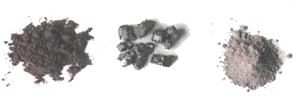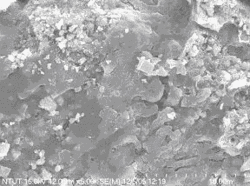Copper flotation waste
| Topics: |
Copper is one of the oldest metals used and has been one of the important materials in the development of civilization. Copper occasionally occurs pure and is found in many minerals such as cuprite, malachite, bornite, chalcopyrite, covellite and azurite. The most important types of copper ores are the sulfides, oxides and carbonates.
Copper can be produced either pyrometallurgically or hydrometallurgically. The hydrometallurgical route is used only in a limited amount of the world’s copper production and is normally only considered in connection with in-situ leaching of copper ores; from an environmental point of view, this is a questionable production route. In the most common hydrometallurgical process, the ore is leached with ammonia or sulfuric acid to extract the copper. These processes can operate at atmospheric pressure leach circuits. Copper is recovered from solution by electrowinning, a process similar to electrolytic refining.
The most widespread method of producing copper is the smelting of copper sulfide concentrates. The raw copper is then refined to copper cathodes, which are further processed to copper semi-products.
Copper slag is a by-product of the copper smelting industry. Of the smelters surveyed, about 35% use flash smelting, 35% use bath smelting, and other technologies cover the remaining 30%. The flash smelting process has been used in copper industry for a number of years and has replaced most of the reverberatory applications, known as “conventional” copper smelting processes. In this process, due to high copper lockup in the slag, a separate processing system consisting of electric furnace slag cleaning, converter for copper matte blowing and fire refining is required. In bath smelting, the concentrate feed is enveloped and reacted in a turbulent bath of matte. The advantage of this important smelting method is the high intensity mode of smelting which enables the added charge to quickly reach smelting temperatures and the chemical reactions to rapidly proceed to completion; this feature translates to smaller-sized furnaces per unit capacity and a high overall efficiency.
It has been estimated that for every ton of copper produced about 2.2 tons of slag is generated and, as a result, each year approximately 24.6 million tons of slag is generated from world copper production. The Turkish State Planning Organisation reported that of the 13.5 million tons of world copper production each year about 67,000 tons of copper and 140,000 tons of slag are produced in Turkey. At older smelters, converter slag was often returned to the reverberatory furnaces to recover the copper it contained. A better recovery of copper from slag is achieved by re-melting it in specialized electric furnaces, or by grinding, followed by flotation. Both processes are now used for slag cleaning. The slag milling-flotation process is used for removal of copper and other recoverable metals from the slag.
Copper slag is a by-product of the copper smelting industry. The molten slag from the smelter is quenched in water and quick cooling of this slag results in amorphous, non-crystalline particulates. Some of the characteristics of copper slag such as hardness, high density, and low free silica content are useful in removing heavy rust and providing a high profile surface finish. Copper slags and flotation wastes are generally disposed of without any prior solid waste treatment in areas around the industrial facility where they are generated. Dumping of such amounts of copper slag causes economic, environmental and space problems. Therefore, governments have implemented policies that give responsibility to mining and metallurgical companies for reducing the volume of solid waste deposition by promoting material recycling and reutilization. Since copper slag and flotation wastes may contain metals such as arsenic, beryllium, chromium, nickel and lead, the air emissions and spent abrasive generated from use of this material may be toxic. The toxicity of the waste is determined by Toxicity Characteristic Leaching Procedure (TCLP) tests and depending on the characteristics of the waste the spent abrasive must be disposed off as solid or hazardous waste.
Because of these strict environmental regulations and due to the reduction or eventual elimination of the cost of copper slag deposition, copper smelters are looking for technological innovation, which involves copper slag utilization. Since the amount of metals present in the slag and copper flotation wastes are minor, their recovery may not be economical by many processes. Therefore, its use in the production of different value-added products like abrasive tools, pavement, abrasive, concrete-cutting tools, tiles, glass, roofing granules, cement, asphalt-concrete aggregate, etc. was explored. Especially important is the development of new ceramic, glass and glass-ceramic materials, made by recycling wastes.

